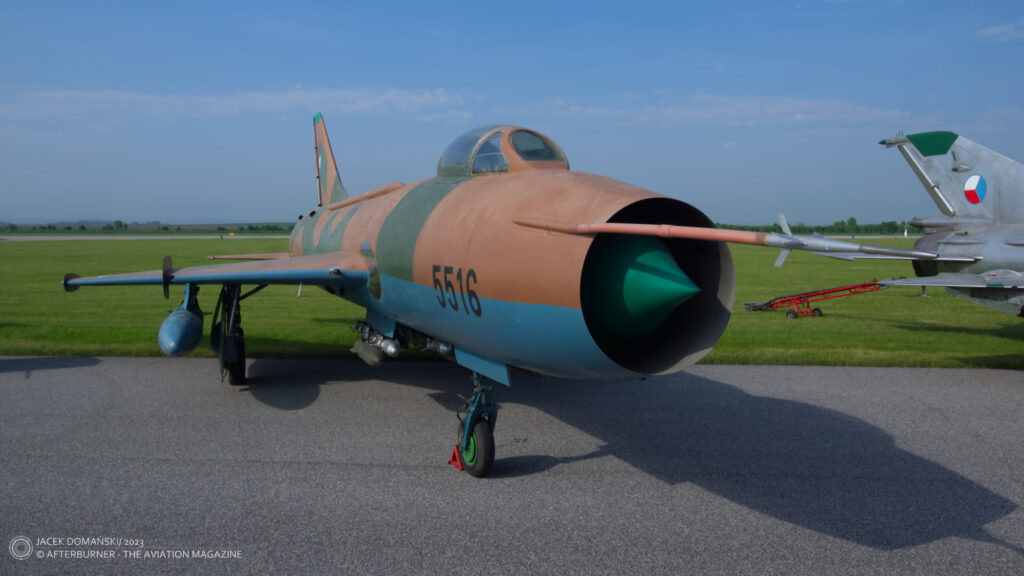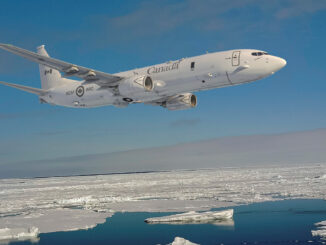 Sukhoi Su-7BM (c/n 5516, formerly ´5516´ of the Czechoslovak Air Force), static display at open doors event at 21st Tactical Air Base, Čáslav, May 2023.
Sukhoi Su-7BM (c/n 5516, formerly ´5516´ of the Czechoslovak Air Force), static display at open doors event at 21st Tactical Air Base, Čáslav, May 2023.
On 14th May 1953, Pavel Sukhoi was appointed the Chief Designer of OKB-1, what, in practice, meant re-opening of his aviation construction bureau that was closed back in 1949. Shortly after, the Sukhoi OKB was assigned its first task of creating two new supersonic fighters, pursuant to the Soviet governmental decree from 5th August 1953.
The first, experimental jet fighter was completed until 1954 and, following satisfactory results of its evaluation flights, was approved for the next stage. It included construction of prototype of supersonic, swept-wing fighter aircraft designated Su-7 (изделие С-2 / izdeliye S-2). It was ready in 1955, and next year was officially presented to the Soviet authorities at Tushino airfield.
Soon after, the Su-7 was approved for serial production that commenced in 1957. Approximately 130 examples of the aircraft were manufactured. Initially, the Su-7 had to be – according to the Soviet official terminology – a ´frontline fighter´, but its flying characteristics did not match that objective. Eventually, the aeroplanes got assigned to fighter regiments in the Soviet Far East. There, the Su-7s became part of the Soviet air defence system and stayed in that role until the mid-1960s.
Although the Su-7 was some kind of disappointment in case of the ´frontline fighter´ duties, its advantages were shortly after used for another project that was a beginning of entire family of successful combat aircraft.
On 17th May 1957, the Soviet armed forces officially issued requirement for a new type of aircraft – jet engine-powered multirole fighter-bomber. The air force authorities recalled about the Su-7 and suggested that Sukhoi should redesign that not very successful aeroplane into the new role. That task was later officially assigned to Sukhoi OKB by a governmental decree dated 31st July 1958.
The first fighter-bomber example of the aircraft, designated Sukhoi Su-7B (изделие С-22 / izdeliye S-22), performed its maiden flight in March of 1959 and its serial production commenced later that year. The aeroplane proved to be excellent for the new role and, as aforementioned, initiated the long line of Sukhoi-designed fighter-bomber jets. Successively modified variants of the Su-7 were produced until 1972, with approximately 1,800 examples built. The family of fighter-bombers based on the Su-7 general idea was then continued with Su-17 and Su-22 aeroplanes. The latter was manufactured until 1990 and nowadays is still operational with a few air forces, although its service days are counted.
The Su-7BM variant (изделие С-22М / izdeliye S-22), pictured above, was introduced into service in 1962. It featured modernized Lyulka AL-7F-1 turbojet engine with increased service life, new onboard equipment, additional fuel tanks to increase the range and, primarily, capability to carry nuclear bombs.
The aeroplane pictured within our Photo of the Week series was manufactured in 1965 and then delivered to the then Czechoslovak Air Force. Initially, the Su-7BM ´5516´ was assigned to the 28th Fighter-Bomber Air Regiment at Čáslav airfield. In 1977, the aircraft was transferred to the 20th Fighter-Bomber Air Regiment in Náměšť nad Oslavou. There, it remained in active service until its retirement in 1988.
After its withdrawal from active service, the ´5516´ was preserved for display purposes. The aircraft was for a few years stored at Náměšť and later moved to Čáslav air base. There, the ´5516´ is being displayed during various aviation events held at the base, such as the open doors day that took place in May of 2023.
Apart from the ´5516´, another Su-7BM can be found within the area of the 21st Tactical Air Base. It is the ´5526´ aeroplane that was restored in 2022 and then became a part of historical aircraft display there.


